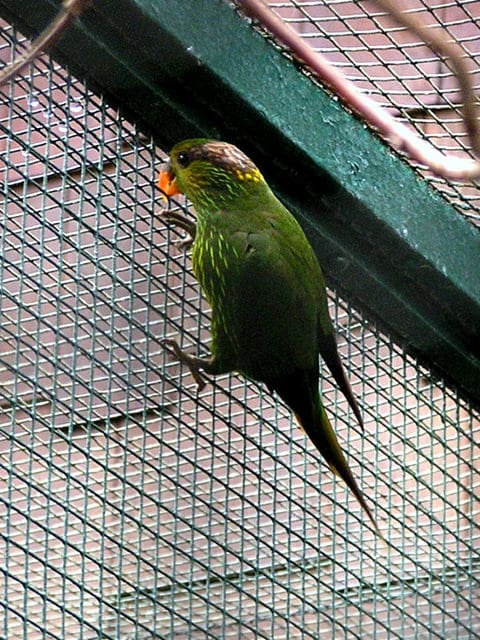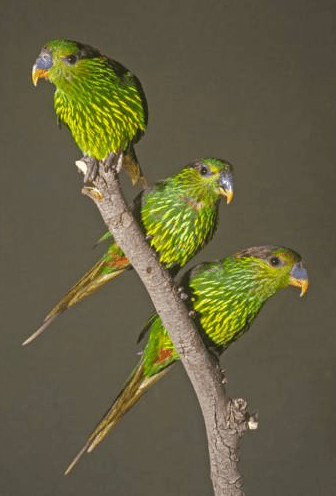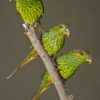Striated Lorikeet
Also known as:
Streaked Lorikeet, Yellow-streaked Lorikeet
Also known as:
Streaked Lorikeet, Yellow-streaked Lorikeet

Charmosyna

multistriata
Size:
18 cm (7 in)
Weight:
40 g (1.4 oz)
Subspecies including nominate:
one
Colour Adult:
Both adults brown hindcrown and nape, with orange/yellow spotting which varies between individuals; dark green breast streaked with yellow/green, the remainder of underparts green streaked with green/yellow; red vent; olive/green tail tipped with dusky yellow, with red bases of lateral feathers. Beak orange with grey at base. Eye red.
Colour Juvenile:
As in adults but orange/yellow spotting on nape duller and smaller.
Call:
Calls are distinctive, with mostly single drawn-out whistles, sometimes becoming two or three notes; some chattering before beginning of whistling calls.
More Information:
Content Sources:
CITES
BirdLife International
Cornell Lab of Ornithology/Birds of the World
A Guide to Parrots of the World, Juniper and Parr, 1998
Parrots of the World, Forshaw, 2006. 2010 edition
Parrots in Aviculture, Low, 1992.
Lexicon of Parrots, Thomas Arndt.
Parrots: Their Care and Breeding, Low, 1986.
Captive Status:
Rare
Longevity:
—
Housing:
Aviary or enclosure with well-drained, tiled or concrete floor, or suspended cage over same.
Diet:
Nectar, either a commercial type formulated for small species or one homemade from lactose free baby cereal, honey, malt extract or molasses, mixed with filtered water and made fresh once or twice daily; fruits such as: apple, pear, peaches, bananas and cactus fruits.
Enrichment:
Provide unsprayed flowering branches. Provide overhead misters or shallow water bowls for bathing.
Nest Box Size:
Vertical box 12 cm x 12 cm x 25 cm (5 x 5 x 10 in).
Clutch Size:
2
Fledging Age:
7 1/2 weeks
Hatch Weight:
—
Peak Weight:
—
Weaning Weight:
—
World Population:
Unknown, decreasing.
IUCN Red List Status:
Least Concern
CITES Listing:
Appendix II
Threat Summary:
A BirdLife “restricted-range” species. There are no data on population trends, however, this species is suspected to be declining slowly due to habitat degradation and the effects of severe weather. A sharp decline was reported from the Tabubil/Ok Tedi area, where flocks of up to 125 birds were once reported, since the severe 1997-98 El Niño drought. Forest loss is low within the range, occurring at a rate of about 0.1% over three generations. Much of the southern slopes of the central range occupied by this species remain well-forested and the rugged terrain affords some protection against human-generated threats.
Range:
Southern slopes of main range in W New Guinea, from Snow Mountains, West Papua, east to Crater Mountain, Papua New Guinea.
Habitat:
Found between 180-1800 m (590-5904 ft) in montane and hilly forest and forest edges.
Wild Diet:
Feeds on flowers of canopy trees and epiphytes, including Dimorphanthera and Poikilospermum.
Ecology and Behaviour:
Seen in pairs or small groups of up to 20 birds. Has been seen in groups with Red-flanked and Fairy Lorikeets. Stays to the tops of flowering trees in the canopy.
Clutch and Egg Size:
2 eggs, 16.4 x 19.7 mm (0.6 x 0.7 in).
Breeding Season:
Not recorded.


![© Dr. Nassar Halaweh [CC BY-SA 2.0] via Flickr A Striated Lorikeet clings to the side of an enclosure](https://parrots.org/wp-content/uploads/2023/01/wpt_Striated-Lorikeet_1251-1-100x100.jpg)
